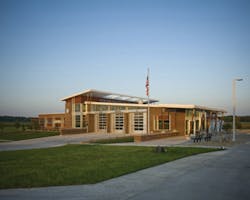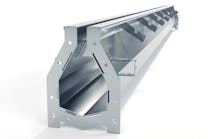Over the past fourteen years writing about new and renovated fire stations, I've seen many trends quickly become new standards for fire and emergency service departments. Today, all new fire stations have a room for fitness equipment and a designated room for cleaning turnout gear. More recently, fire stations have included separate laundry machines for washing stationwear rather than have firefighters' on-duty clothes washed in their family machines.
New terminology has also evolved from firehouse trends. A few years ago, Chief Bryan Dehner, Overland Park, Kan. Fire Department, used the term "occupational athletes" in describing firefighters and police who put an extraordinary strain on their body when responding to a call. Dehner reiterated the importance of the fitness room being an integral part of a fire station. Not only is there a need for treadmills and exercise machines, but attention to allocating additional floor space for core body strength exercises.
"Firefighter-resistant" is a term offered by Dennis Ross, principal, Pacheco Ross Architects versus "firefighter-proof." Ross was referring to a number of durable products for use inside new fire stations. Walls of tan-colored concrete blocks are ground to reveal the stone mixture, yet wear for years without painting or treatment. While lounge chairs in many day rooms appear to be oversized and luxurious compared to residential models, the hardiness and durability are also deemed firefighter-resistant.
Architect Brian Harris, TCA Architects believes that fire stations have evolved from "green" to "high-performance" fire stations that are environmentally complimentary or sustainable. Harris believes the newest generation of fire stations actively contribute to their use and the return-on-investment could be considered as high-performance fire stations.
One high-performance station is the Madison, Wis., Fire Station No. 12 and it is certified Leadership in Energy and Environmental Design (LEED) Platinum by the U.S. Green Building Council. Noteworthy design elements include: a geo exchange system that is the sole source for heating and cooling the building; a green roof with vegetation in place of conventional roofing materials; xeriscaping that reduces the amount of high-maintenance turf in the landscaping (no mowing!) and a storm water collection system for general non-potable water use.
Serious consideration of the alignment of Station 12 east and west enhanced the solar heat gain versus placing the station another direction and offered optimal daylight configuration.
If you are even thinking about building or renovating your fire station, it's not too soon to start doing your homework on the evolution of fire stations today. One good place to start would be the one-day, Station Design Conference, to be held on Wednesday, July 16, during Firehouse Expo in Baltimore.
Investing your time early in the process of designing a new fire station will not only save you from costly mistakes, but can offer you insights to building the best fire station for your department and your community. I promise!
JANET WILMOTH grew up in a family of firefighters in a suburb of Chicago. Wilmoth, owner of Wilmoth Associates, worked with Fire Chief magazine for 27 years until it closed in 2013. She is currently a Project Director for Firehouse/Cygnus. Wilmoth currently serves on the Board of Directors for the Fire Emergency Manufacturers & Services Association and lives in Lisle, IL.






